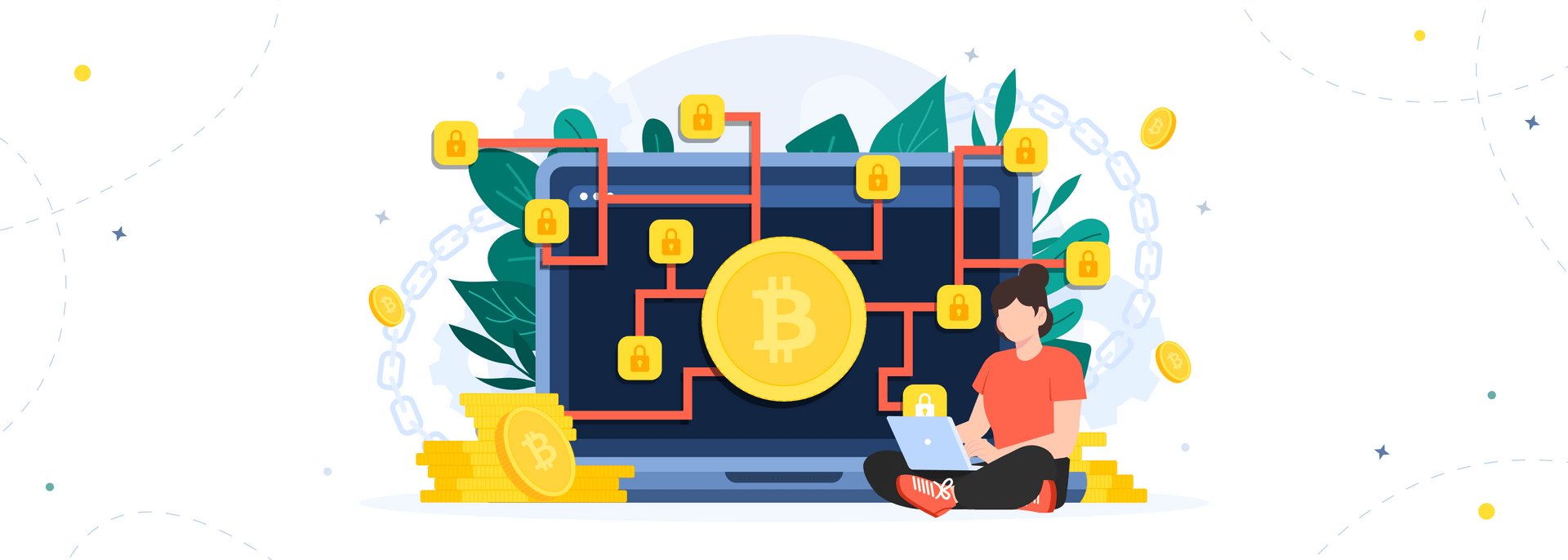What associations does the word blockchain evoke in you?
We’d wager that it makes you think of Bitcoin, cryptocurrency exchange, ICOs, and other crypto-related stuff. However, there is much more to this technology. Blockchain is used in plenty of industries besides crypto, from gambling to healthcare to real estate to music. Its market size is currently estimated at more than ten billion dollars and is expected to exceed $1.59 trillion (!) by 2030.
Considering such rapidly-growing popularity, it’s about time we presented a guide to blockchain app development. As a company that cares about your results, we at AnyforSoft want to ensure that you leverage blockchain capabilities to the full and create a valuable product that will generate steady income for your business.
That’s why we’ve put together this article and addressed the following questions:
- What are blockchain applications and how do they work?
- What benefits does blockchain technology have?
- What are its use cases?
- How to develop a blockchain application from scratch?
Hopefully, you will find this information helpful.
Blockchain Applications: what they are, how they work
Before describing how to build a blockchain app, we first need to understand what blockchain applications are. And to understand what blockchain technology applications are, we should first learn how the technology works.
Blockchain basics
In layman’s terms, a blockchain is a network that stores received data chronologically in blocks. When a financial transaction or another data exchange takes place in the blockchain network, it is shared among all its participants (peers), and everyone receives a record of it. These blocks of data are stored in a chain, and once a new piece of data appears in there, it cannot be changed. This makes blockchain highly secure.
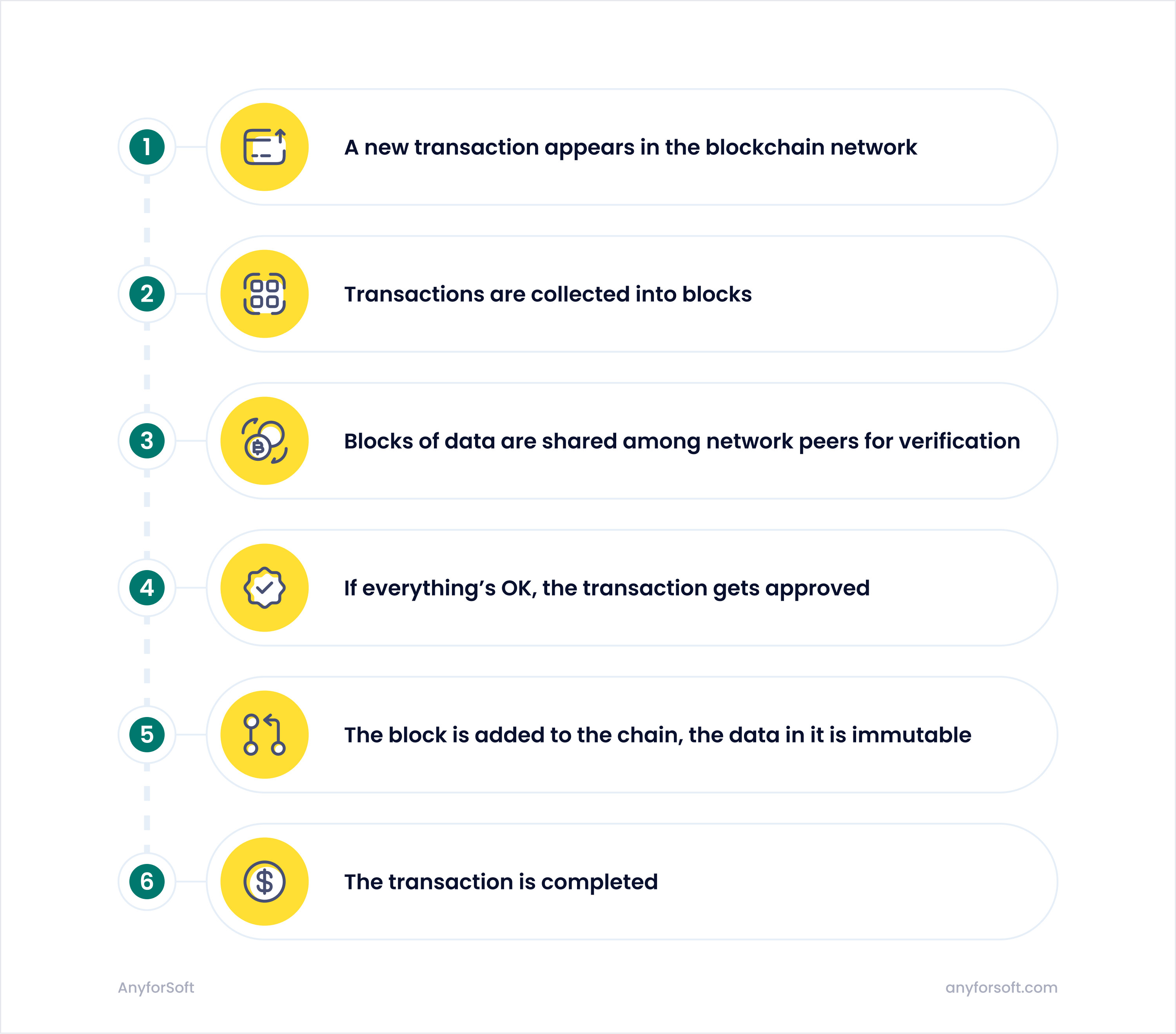
There are two types of blockchain networks you can build:
- Permissionless blockchain. A permissionless blockchain system is open to all its peers—they have access to the code, can verify data exchanges, and interact with each other while remaining anonymous. For example, Bitcoin is based on a permissionless blockchain network.
- Permissioned blockchain. Permissioned blockchain, in contrast, allows only authorized users, with each being assigned a specific role and permissions. It is based on a set of rules that regulate data exchange between network participants. This type of blockchain system is a great solution for organizations that want to securely manage various operations.
What are blockchain apps
Given the above, we can conclude that blockchain applications (also known as decentralized applications or DApps) are solutions based on blockchain networks. Unlike traditional applications, decentralized apps don’t use servers as an intermediary between users and transferred data. Their backend is run in a peer-to-peer network, with each participant’s device serving as a part of the server. That’s why blockchain application development is considerably different from the creation of traditional solutions.
However, from the end user’s perspective, a blockchain application looks just like any other traditional app, so your target audience won’t have any issues using it.
Benefits of Blockchain Development
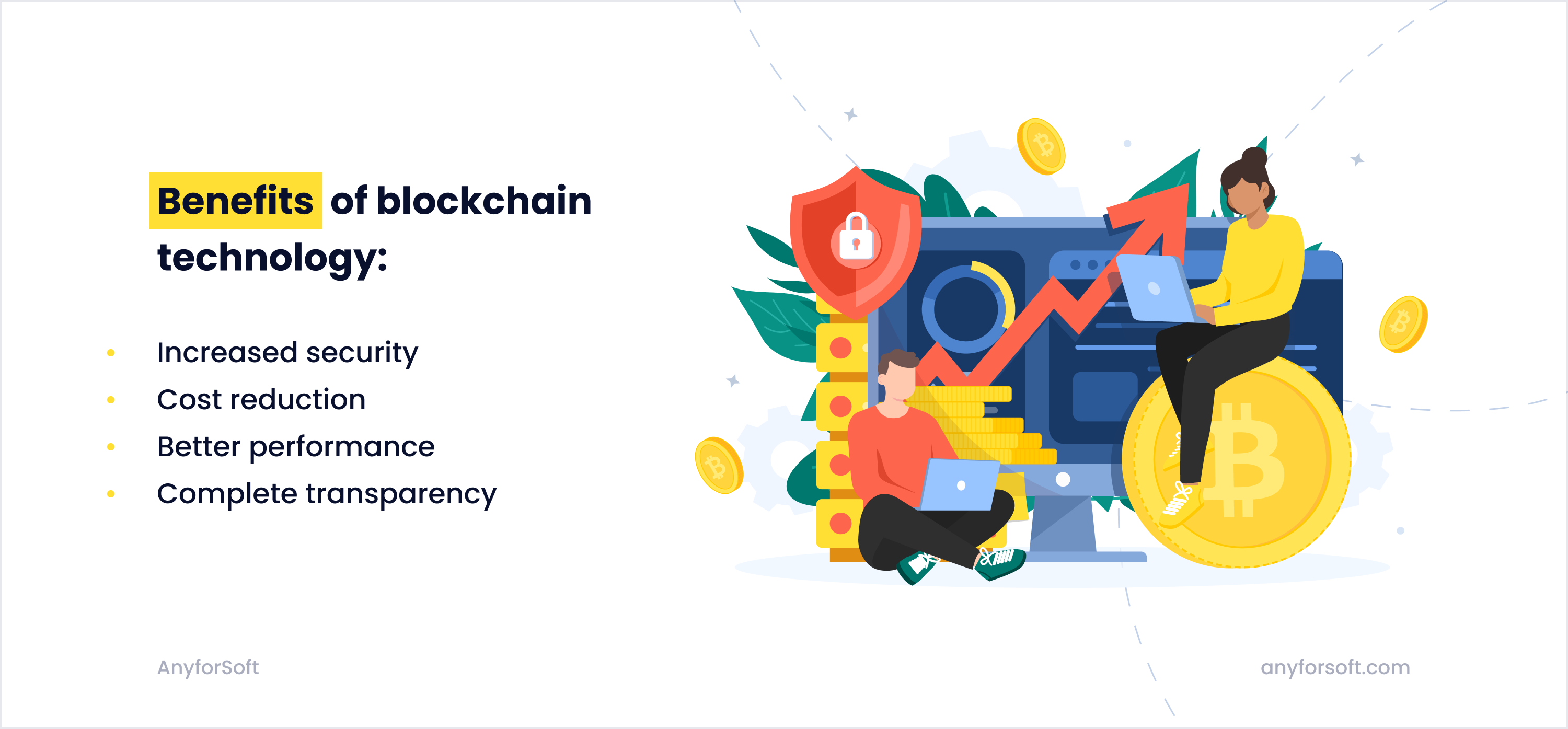
We believe blockchain app development is worth investing in for the following reasons:
- Increased security. Decentralized solutions are more secure than traditional ones by default. Blockchain-based apps come with advanced encryption and security mechanisms to ensure the safety of your system. To steal data from blockchain solutions, a hacker would have to gain access to more than half of the devices of its participants, which is nearly impossible.
- Cost reduction. Blockchain application development will result in a solution that eliminates intermediaries from data exchange. Thus, you can develop a blockchain app without spending money on third-party service providers. Plus, DApps reduce manual work such as aggregating and amending data while facilitating reporting and auditing processes.
- Better performance. Another benefit of blockchain technology is speed. Due to eliminating intermediaries as well as many manual processes, blockchain handles data exchange way faster than conventional technologies.
- Complete transparency. As noted above, data exchange is shared among all participants of a blockchain, and each receives a record, making the system completely transparent and traceable. That’s beneficial for many businesses. For example, Walmart leverages blockchain to trace the origins of transactions and thus better manage product inventory. When a particular farm recalls its products due to contamination, the retailer identifies and removes the produce that comes from that farm with the help of blockchain technology.
Blockchain use cases
Blockchain can be used in various ways and benefit different industries. Let’s look at some popular use cases for the technology.
Smart contracts
A smart contract is a self-executing contract with terms and conditions between two or more parties that doesn’t require the involvement of an intermediary. The code and the agreements contained in the contract exist within a decentralized blockchain network.
In a nutshell, smart contracts follow simple “when/if…then…” rules written into code on a blockchain. They execute specified actions when predetermined conditions have been fulfilled. For example, you as a buyer could enter into a contract with the seller that once a shipment arrives at your post office, a certain amount of electronic money is sent to the seller’s account.
Since smart contracts remove administrative overhead and accelerate many processes, they are considered one of the most attractive features associated with blockchain. Such blockchain solutions are used in many industries, including real estate, healthcare, finance, retail, and others.
Cryptocurrency creation
Blockchain development enables you to create your own cryptocurrency and blockchain wallet. Luckily, the Bitcoin source code is available for anyone to explore, which allows blockchain app developers to create cryptocurrencies similar to Bitcoin. While the software development process is expensive and complicated, it is still possible.
Internet of things (IoT) solutions
The Internet of Things (IoT) is basically a network of physical objects (referred to as “things”) that use sensors, software, or other technologies to communicate with other devices and systems via the internet. A simple example is a smartwatch that is integrated with your phone and sends you notifications whenever you receive a text message or someone is calling you.
The problem with IoT devices is their security: if a threat actor succeeds in hacking one of the devices from your network, they will likely gain access to sensitive data on your other devices.
Blockchain in IoT solutions prevents that. By creating a decentralized ledger of all transactions, blockchain makes the system more secure, not allowing anyone to tamper with data.
Blockchain in industries
Besides the use cases described above, blockchain is also used in:
- Music. Spotify implements the technology to create a decentralized connection between music tracks, artists, and licensing agreements.
- Logistics. Shipping company Maersk uses blockchain to streamline supply chain management and monitor goods across international borders in real time.
- Education. Many e-learning platforms and educational institutions (such as the University of Nicosia) integrate blockchain into their control systems and document storage, preventing data breaches and unauthorized alterations.
- Entertainment. The free-to-play strategy game Plague Hunters has a built-in Ethereum marketplace that uses NFT transactions for purchasing and selling game items.
- Healthcare. ConnectingCare invested in blockchain development to create a network that allows for secure data exchange between patients and doctors.
How to Build a Blockchain Application in 6 Steps
Now that you understand the basics of blockchain software and are aware of the benefits this technology can bring to your business, it’s about time we showed you how to develop blockchain applications. Note that the DApp development process will vary depending on the type of software you aim to build, its complexity, functionality, your budget, and numerous other factors. However, in general, the process looks like this.
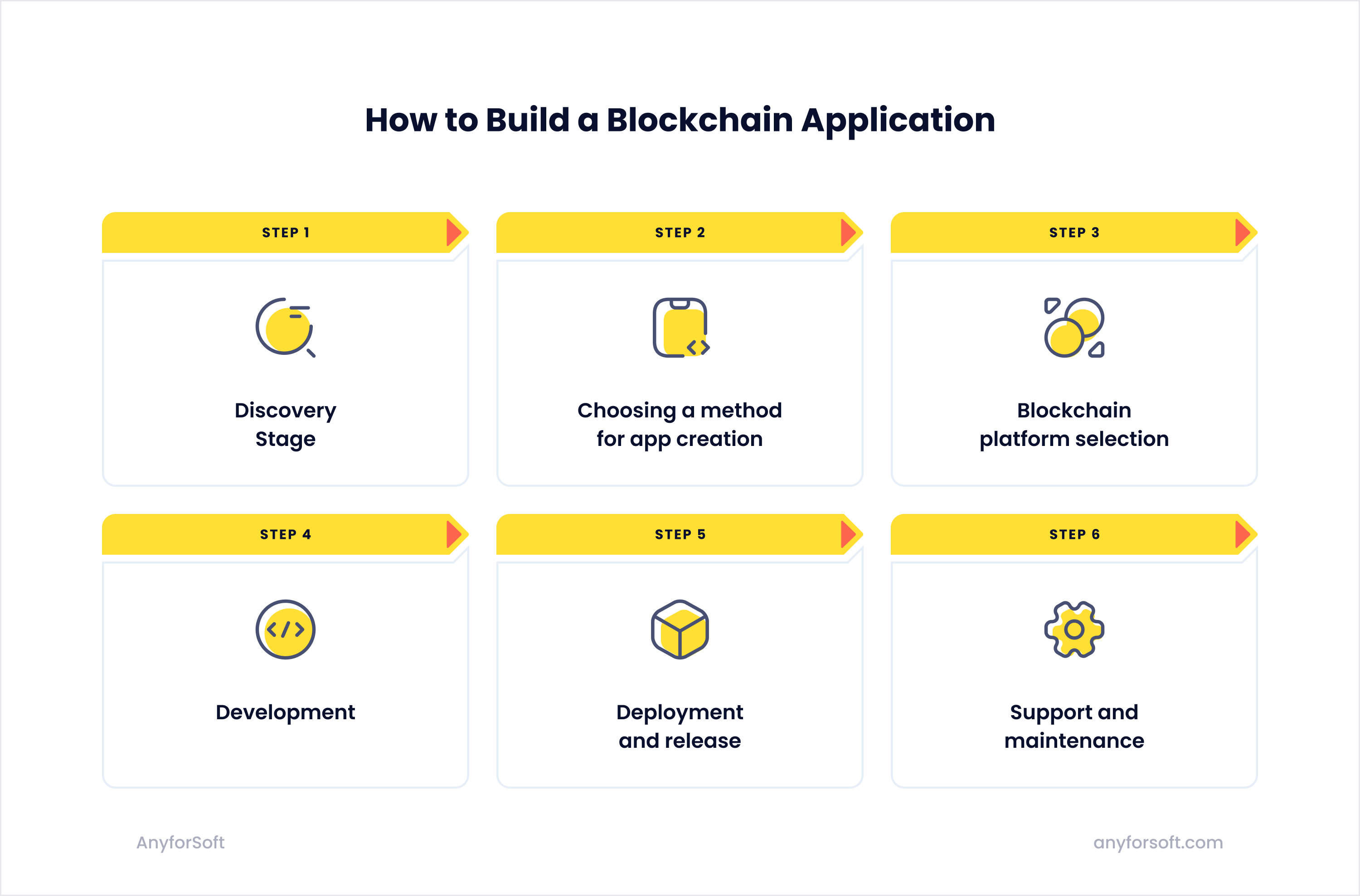
Step 1: Start with the discovery stage
In a nutshell, the discovery phase is when you conduct market research and gather the information required to successfully launch your blockchain technology application. At this development stage, you identify your target audience and find their pain points and needs. A thorough project discovery also helps you and your team:
- Come up with a unique project idea and get a clear vision of the final product.
- Set up business goals realistically. Get business and technical requirements.
- Estimate blockchain app development budget.
- Plan the development process in minute detail and choose an appropriate tech stack.
- Prevent risks.
Once you have collected the required data, you can fine-tune your initial idea to create a product that addresses the expectations, pain points, and needs of your potential customers. Instead of relying on guesswork, you will be able to create a blockchain solution with real data in mind, increasing the likelihood of success.
We have a big article on the project discovery phase—consider reading it to learn how to conduct it.
Step 2: Choose the way you want to build a blockchain app
There are four ways of developing a blockchain application from a technical perspective:
- You can use an open blockchain for your application. For example, Bitcoin has open-source code, so you can integrate this cryptocurrency into your mobile or web application.
- You can also build a private blockchain.
- Another option is to choose a BaaS (Blockchain as a Service) provider and integrate their cloud service into your mobile or web app.
- Lastly, you can build your blockchain network with the help of a blockchain platform (there are many popular blockchain development platforms that you can choose from).
Speaking of blockchain development platforms, many app creators use them to facilitate blockchain application development.
Step 3: Choose an appropriate blockchain platform
There are multiple platforms you can utilize to create a blockchain app. The most popular are:
Ethereum
This open-source blockchain platform allows you to build a DApp (web and mobile apps), develop smart contracts, and create ICOs. Ethereum uses its own language called Solidity, so you have to know it in order to use the full potential of the platform.
Hyperledger Fabric
This blockchain platform is widely used by organizations that deal with supply chain management and connected devices. Hyperledger Fabric can help you create permissioned networks for safe data exchange within your company. The platform requires command of Go, Java, and JavaScript. programming languages.
EOS
The EOS blockchain platform can be used for the development of decentralized applications relying on smart contracts. It provides decentralized app hosting, decentralized storage, and smart contracts features.
R3 Corda
R3 Corda is mostly used for creating permissioned blockchains. You can integrate the platform with an existing system if you have one.
OpenChain
As the name suggests, OpenChain is an open-source platform for blockchain app development. It uses a single authority to validate data exchange and transactions. Its main clients are companies that want to securely manage digital and crypto assets. OpenChain doesn’t charge transaction fees, which is one of the advantages of the platform.
More blockchain platforms to consider: Ripple, NEO, IBM Blockchain, Hyperledger Sawtooth, Tezos, Stellar, ConsenSys Quorum.
The choice of platform will dictate the skill set required from the developers you hire. Many platforms work with conventional programming languages such as C++, Java, and JavaScript while others support less widespread languages such as Solidity and Simplicity. Consider this before hiring developers for your startup.
Step 4: Start the development
Once you’ve done market research, decided on the way you wish to make a blockchain app, and found an appropriate blockchain platform, it’s time to start blockchain app development. At this stage, you should write code for the backend and frontend, design visual elements for your application, develop the app’s core features and functionality, and thoroughly test everything you’ve created.
Obviously, if you’re not a developer, a designer, and a QA engineer all rolled into one, you will need a product development team. Conveniently, we have a guide explaining how to build one—check it out if you haven’t already. By delegating technical tasks to professionals, you will be able to focus on the business side of your product.
Step 5: Deploy and release your application
When the app’s code is ready and all the features are developed and tested, it’s time for deployment and release. You have to:
- Deploy your mobile app to major app platforms—App Store and Google Play.
- Set up a consumer web application in a cloud service.
- Deploy blockchain code to the mainnet.
Another benefit of working with a professional team is that they also take care of deployment and release, save you the headaches associated with these processes.
Step 6: Support and maintain your software
Finally, your application is released. However, it’s not the end, as from this point you have to continually maintain it.
Every application requires regular maintenance and support to ensure that it works smoothly and without errors. You should conduct regular security checks to prevent vulnerabilities, timely resolve on-page issues, monitor performance, test usability, and review the app’s compliance with HIPAA, GDPR, PCI DSS, GLBA, and other regulations. If you fail to resolve issues with your web/mobile application, it will damage the user experience, resulting in revenue loss. Thus, make sure that you have a team that takes care of the technical side of your software solution.
Blockchain app development costs and time
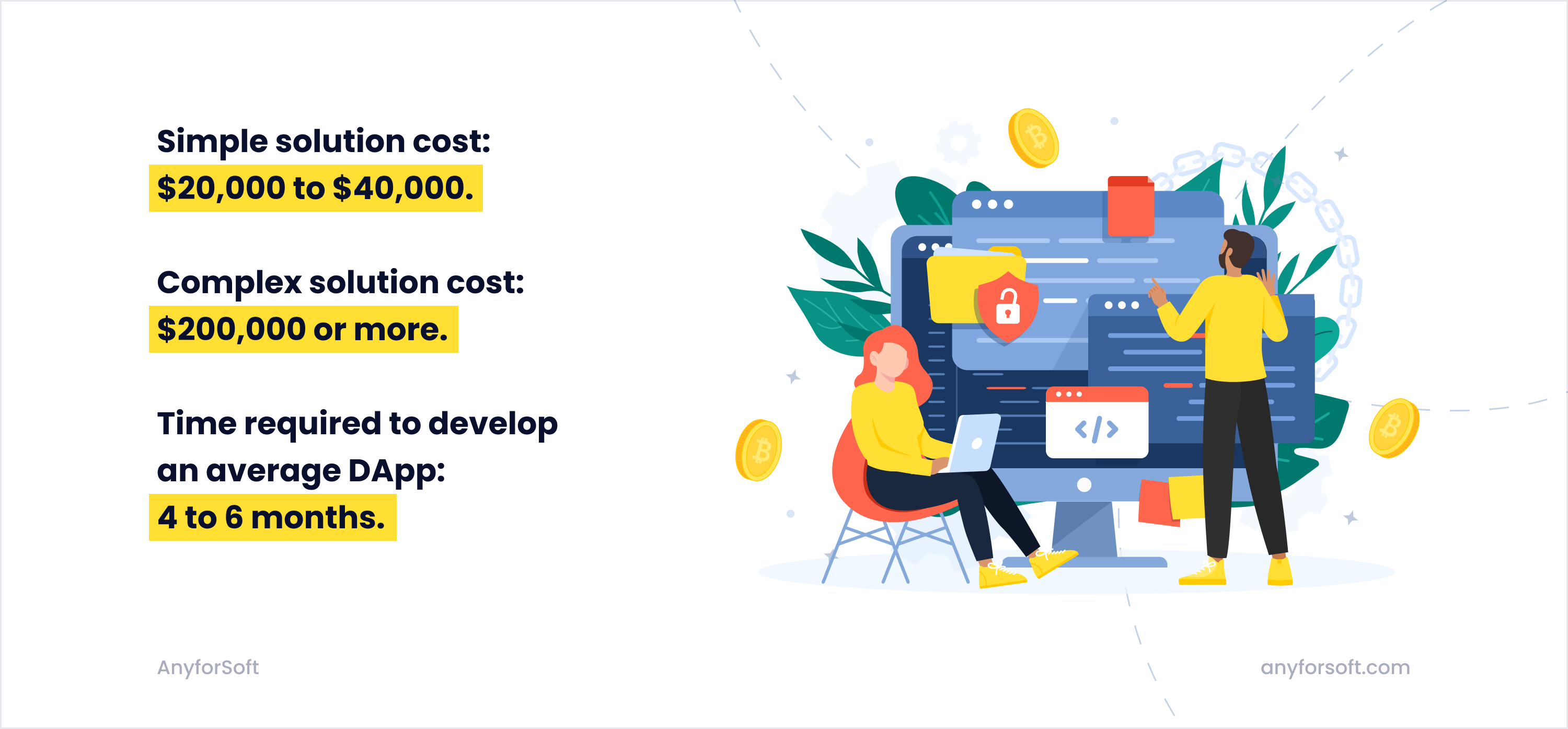
Now that you got an idea of how to build a blockchain app, you’re probably wondering how much it is going to cost. Well, the cost of building a blockchain application depends on the app’s complexity, the number of features it will have, the chosen platform it will be built with, a tech stack, and other factors. A simple solution may cost between $20,000 to $40,000, whereas a complex application will require an investment of $200,000 or even more.
Also, we should take into consideration the country you will hire software developers from. If you’re living in the US, Canada, or the UK, consider outsourcing your project using the offshoring model. This option boasts a huge talent pool and can help you save thousands of dollars on development.
As for time estimates, the development of an average DApp usually requires from 4 to 6 months.
To receive an accurate time and cost estimate for your project, don’t hesitate to contact us and tell us more about the solution you aim to create. Our team will take all the factors into account and timely provide you with estimates.
Factors to consider for blockchain application development
Before embarking on blockchain development project, there are multiple factors you should consider. Let's review them:
- Blockchain platform. The market offers plenty of popular blockchain platforms for developing blockchain applications. Analyze the market and choose a solution that best fits your needs.
- Purpose and use case. Before opting for blockchain development, you should clearly define the purpose of your blockchain solution and the problem it aims to solve. Understand how blockchain technology can add value to your specific use case and make sure that blockchain software development is the right choice.
- Smart contracts. You need to determine whether you require a smart contract.
- Consensus protocol. Blockchain development platforms work on different consensus protocols, such as Proof of Work (PoW), Proof of Stake (PoS), Proof of Elapsed time (PoET), Proof of Burn (PoB), etc. Your choice will significantly impact security, scalability, and how your blockchain application works.
- Public/Private Network. There are two types of blockchains: private networks and public networks. Obviously, your blockchain developers should know which type of network to build. Your decision will also dictate the choice of platform for blockchain-based application development.
- Scalability. Before using blockchain, determine how you're going to scale your application as it grows. Scalability might be very challenging, and you should have a plan for handling increased transaction volume.
- Data security. You can't use blockchain without taking care of data security. Before opting for blockchain development, consider how you will handle sensitive data and compliance with regulations like GDPR or HIPAA.
Blockchain Application Development with AnyforSoft
To successfully create DApps, you need to have an in-depth understanding of blockchain technology and know various programming languages (including rare ones). As a business owner, you are probably not interested in development intricacies and don’t have time to delve into them. All you want is to focus on the business side and have someone create software in accordance with your product vision, business needs, and requirements.
Is that right?
If so, we can help.
AnyforSoft is a software development company with more than 10 years of experience that creates complex software solutions for companies in multiple industries. We build professional teams that care about the ideas of our customers and create unique, top-notch, and competitive products. 25% of our developers are senior-level specialists and software architects, which allows us to develop a blockchain application of any size and complexity.
Don’t hesitate—contact us today and let’s start mutually beneficial cooperation.
FAQs
The market offers a plethora of blockchain development tools for various needs. First of all, there are multiple blockchain development platforms and frameworks (Ethereum, Hyperledger Fabric, EOS, Binance Smart Chain (BSC), etc.). If you need to create a smart contract, you might also consider Solidity or Viper. If you require integrated development environments, there are also plenty of tools for you, such as Visual Studio Code, Remix, Ganache, and so on. As you can see, it all depends on your goals. If you need a consultation regarding what tool to choose, feel free to contact us via the website form.
The market offers a plethora of blockchain development tools for various needs. First of all, there are multiple blockchain development platforms and frameworks (Ethereum, Hyperledger Fabric, EOS, Binance Smart Chain (BSC), etc.). If you need to create a smart contract, you might also consider Solidity or Viper. If you require integrated development environments, there are also plenty of tools for you, such as Visual Studio Code, Remix, Ganache, and so on. As you can see, it all depends on your goals. If you need a consultation regarding what tool to choose, feel free to contact us via the website form.
The main difference between public and private blockchains lies in their level of accessibility and decentralization. Public blockchains are open, highly decentralized, and offer transparency to the general public. Private blockchains are permissioned, less decentralized, and provide controlled access and privacy for known participants. The choice between the two depends on the specific use case, trust requirements, and the desired level of decentralization. Some projects may even opt for hybrid solutions that combine elements of both public and private blockchains. Before implementing blockchain, you should decide which type of network will better fit your project needs and requirements.
The main difference between public and private blockchains lies in their level of accessibility and decentralization. Public blockchains are open, highly decentralized, and offer transparency to the general public. Private blockchains are permissioned, less decentralized, and provide controlled access and privacy for known participants. The choice between the two depends on the specific use case, trust requirements, and the desired level of decentralization. Some projects may even opt for hybrid solutions that combine elements of both public and private blockchains. Before implementing blockchain, you should decide which type of network will better fit your project needs and requirements.
Yes, blockchain technology can be integrated into various business processes across different industries to enhance transparency, security, and efficiency. As noted above, the technology is used in many industries and for various reasons:
- Music. Spotify implements the technology to create a decentralized connection between music tracks, artists, and licensing agreements.
- Logistics. Shipping company Maersk uses blockchain to streamline supply chain management and monitor goods across international borders in real time.
- Education. Many e-learning platforms and educational institutions (such as the University of Nicosia) integrate blockchain into their control systems and document storage, preventing data breaches and unauthorized alterations.
- Entertainment. The free-to-play strategy game Plague Hunters has a built-in Ethereum marketplace that uses NFT transactions for purchasing and selling game items.
- Healthcare. ConnectingCare invested in blockchain development to create a network that allows for secure data exchange between patients and doctors.
Whatever industry you operate in, you can also use blockchain to improve the efficiency and security of your day-to-day processes.
Yes, blockchain technology can be integrated into various business processes across different industries to enhance transparency, security, and efficiency. As noted above, the technology is used in many industries and for various reasons: Music. Spotify implements the technology to create a decentralized connection between music tracks, artists, and licensing agreements. Logistics. Shipping company Maersk uses blockchain to streamline supply chain management and monitor goods across international borders in real time. Education. Many e-learning platforms and educational institutions (such as the University of Nicosia) integrate blockchain into their control systems and document storage, preventing data breaches and unauthorized alterations. Entertainment. The free-to-play strategy game Plague Hunters has a built-in Ethereum marketplace that uses NFT transactions for purchasing and selling game items. Healthcare. ConnectingCare invested in blockchain development to create a network that allows for secure data exchange between patients and doctors. Whatever industry you operate in, you can also use blockchain to improve the efficiency and security of your day-to-day processes.
